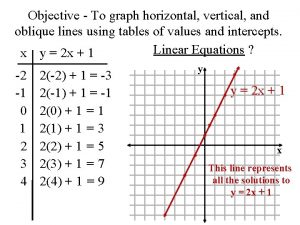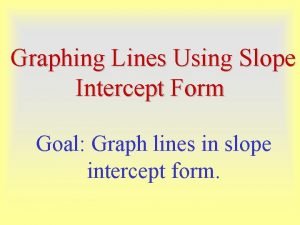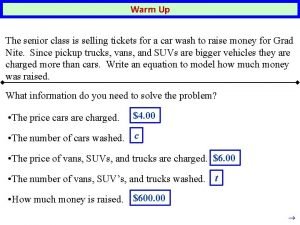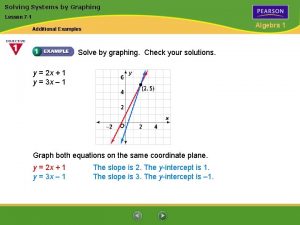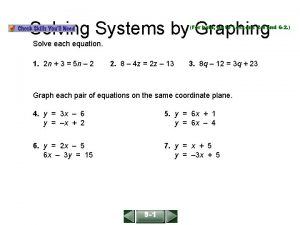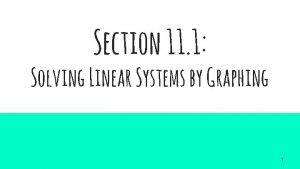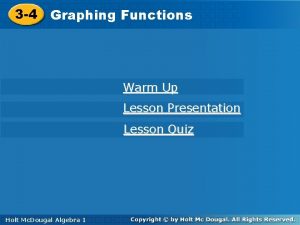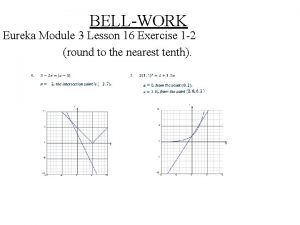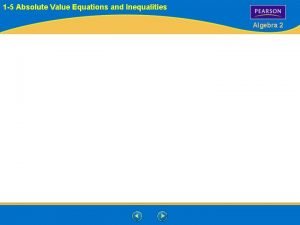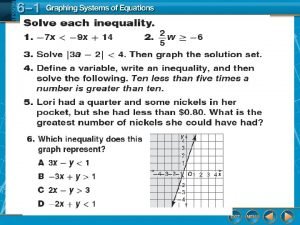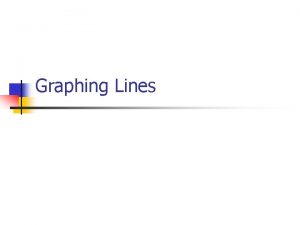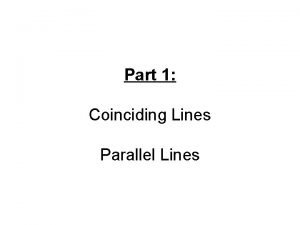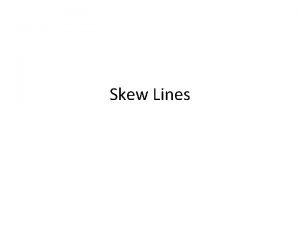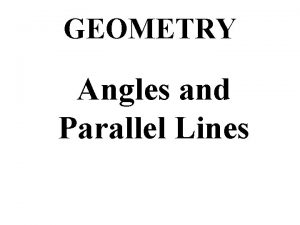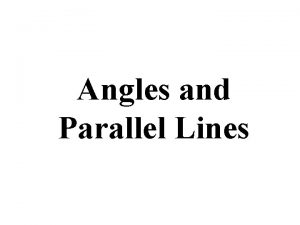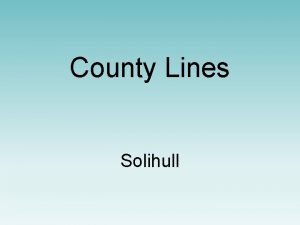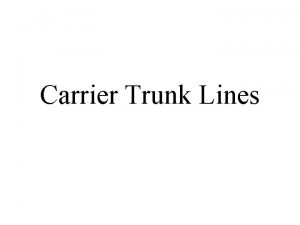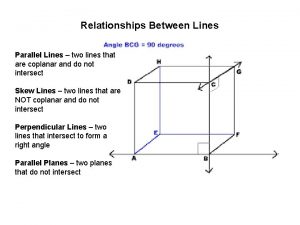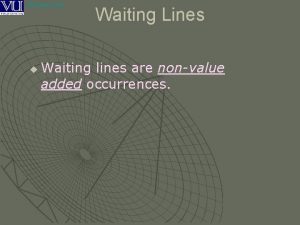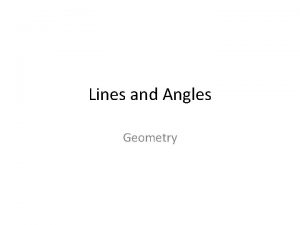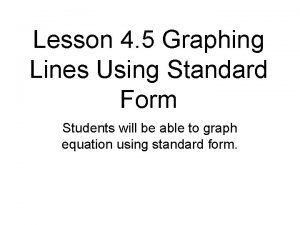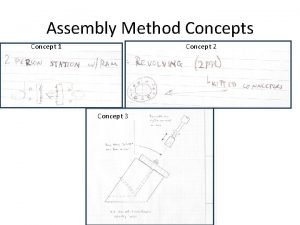Lesson 2 5 Graphing Lines Concept Graphing Lines






















- Slides: 22

Lesson 2. 5 – Graphing Lines Concept: Graphing Lines EQ: How do we graph linear equations? CED 2 Vocabulary: Coordinate Plane Slope intercept form Independent Variable Dependent Variable 1

Standard: A. CED. 2 Create equations in two or more variables to represent relationships between quantities; graph equations on coordinate axes with labels and scales. ★ Brainstorm…. (2 minutes) Write down as many things as you can that you think relate to the standard we are learning today. 2

Did you remember… • Linear equations have a constant rate of change. • The slope of a linear graph is a measure of the rate of change of y with respect to x. (Rise over Run) • The y-intercept of the equation is the point at which the graph crosses the y-axis and the value of x is zero. • Linear equations in two variables can be written in slope-intercept form y = mx + b, where m is the slope and b is the y-intercept. 3 1. 3. 1: Creating and Graphing Linear Equations in Two Variables

• The independent variable is the quantity that changes based on values you choose. The independent variable will be labeled on the x-axis • The dependent variable is the quantity that is based on the input values of the independent variable. The dependent variable will be labeled on the y-axis. 4 1. 3. 1: Creating and Graphing Linear Equations in Two Variables

Let’s see if we can graph the line below… Example 1 Graph the line y = 2 x - 3 5

Graphing using a Table of Values 1. Draw a table x y 2. Choose three inputs (x values) x -1 0 2 y 1. 3. 1: Creating and Graphing Linear Equations in Two Variables 6

3. Substitute the inputs into the equation to find the outputs or y-values x -1 0 2 y= 2 x - 3 2(-1) – 3 2(0) – 3 2(2) – 3 y -5 -3 1 7

4. Draw a coordinate plane. Be sure to label the x and y axis and write in an appropriate scale. x -1 0 2 y -5 -3 1 y x 8

5. Plot the points and connect. x -1 0 2 y -5 -3 1 y . . . x 9

Example 2: Graph the line y = -3 x + 1 x y y x 10

Example 3: Graph the line y = 10 x + 20 *you will need to choose a scale for this problem x y 11

Next we will graph lines using slope-intercept form (y = mx + b) Example 4: Graph the line y = 1. Make sure the equation is in y = mx + b form. You may have to solve the equation for y. Our equation is already in y = mx + b form, so on to step 2…. 12

2. Identify the slope of the line (this is the coefficient of x) and the y-intercept (b). m = ½ b = -3 13

3. Plot the y-intercept on a coordinate plane. . 14

4. Use the slope to find the next point. Rise the numerator Run the denominator . . 15

5. Connect the points. . . 16

Example 5: Graph the line m= Fall 2 (negative) Run 1 . . b=5 17

Example 6: Graph the line 3 x + 5 y = 10. We will need to solve this equation for y…. 3 x + 5 y = 10 -3 x 5 y = -3 x + 10 18

Next we will identify the slope and y-intercept so that we can graph the line. b=2 . . 19

Your turn…. 1. Graph the line y = 4 x – 3 using a table of values. 20

Your turn… 2. Graph the line y = 3 x – 5 using slope-intercept form. 21

Summary…. Your classmate, Lucy, was absent when we learned how to graph lines. She ask you for your notes. You only have 90 seconds to explain the notes to Lucy, what do you tell her? (yes you may use an example…after all a picture is worth a thousand words) 22
 It is used to draw vertical and oblique lines
It is used to draw vertical and oblique lines Graphing lines in slope intercept form
Graphing lines in slope intercept form Graphing horizontal and vertical lines
Graphing horizontal and vertical lines Lesson 12-1 graphing on the coordinate plane answer key
Lesson 12-1 graphing on the coordinate plane answer key Lesson 7 solve systems of equations by graphing
Lesson 7 solve systems of equations by graphing 4-4 graphing sine and cosine functions worksheet answers
4-4 graphing sine and cosine functions worksheet answers Lesson 7 - graphing radical equations and inequalities
Lesson 7 - graphing radical equations and inequalities Lesson 9-1 slope
Lesson 9-1 slope Lesson 11-1 solving linear systems by graphing answer key
Lesson 11-1 solving linear systems by graphing answer key Lesson 2-1 graphing two-variable equations
Lesson 2-1 graphing two-variable equations Lesson 3-4 graphing functions
Lesson 3-4 graphing functions 3.1 graphing relationships
3.1 graphing relationships Lesson 5 graphing linear equations and inequalities
Lesson 5 graphing linear equations and inequalities Graphing systems of inequalities lesson 2-2
Graphing systems of inequalities lesson 2-2 Lesson 16 solving and graphing inequalities
Lesson 16 solving and graphing inequalities Lesson 3-1 graphing relationships
Lesson 3-1 graphing relationships Absolute value equations and inequalities lesson 1-3
Absolute value equations and inequalities lesson 1-3 Lesson 14 graphing the tangent function
Lesson 14 graphing the tangent function 6-1 graphing systems of equations answers
6-1 graphing systems of equations answers Lesson 5-2 graphing polynomial functions answers
Lesson 5-2 graphing polynomial functions answers Real self and ideal self concept
Real self and ideal self concept Contoh selling concept
Contoh selling concept Lesson 1 introduction to waves
Lesson 1 introduction to waves
